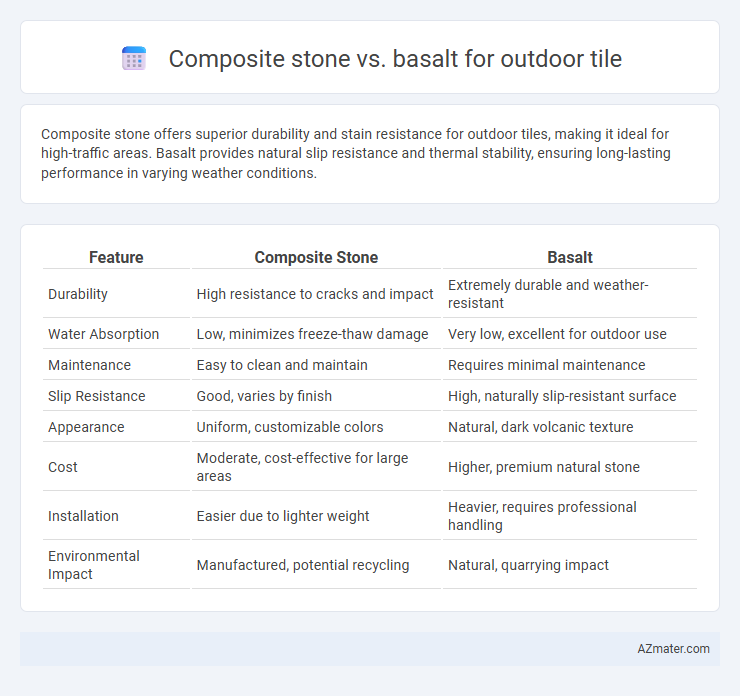Composite stone offers superior durability and stain resistance for outdoor tiles, making it ideal for high-traffic areas. Basalt provides natural slip resistance and thermal stability, ensuring long-lasting performance in varying weather conditions.
Table of Comparison
| Feature | Composite Stone | Basalt |
|---|---|---|
| Durability | High resistance to cracks and impact | Extremely durable and weather-resistant |
| Water Absorption | Low, minimizes freeze-thaw damage | Very low, excellent for outdoor use |
| Maintenance | Easy to clean and maintain | Requires minimal maintenance |
| Slip Resistance | Good, varies by finish | High, naturally slip-resistant surface |
| Appearance | Uniform, customizable colors | Natural, dark volcanic texture |
| Cost | Moderate, cost-effective for large areas | Higher, premium natural stone |
| Installation | Easier due to lighter weight | Heavier, requires professional handling |
| Environmental Impact | Manufactured, potential recycling | Natural, quarrying impact |
Introduction to Outdoor Tile Materials
Composite stone and basalt are popular outdoor tile materials known for their durability and aesthetic appeal. Composite stone combines natural stone fragments with resin, offering enhanced resistance to weather, stains, and wear, while basalt, a dense volcanic rock, provides exceptional strength and natural slip resistance for outdoor environments. Both materials perform well under harsh weather conditions but differ in maintenance requirements and textural finish options.
Overview of Composite Stone Tiles
Composite stone tiles combine natural stone fragments with resin binders, creating durable and lightweight surfaces ideal for outdoor applications. They offer superior resistance to weathering, scratches, and stains compared to natural basalt, ensuring long-lasting aesthetic appeal. Engineered for enhanced consistency and easy maintenance, composite stone tiles provide an efficient alternative to traditional basalt tiles in exterior flooring projects.
Key Features of Basalt Tiles
Basalt tiles offer exceptional durability and natural resistance to weathering, making them ideal for outdoor applications where exposure to elements is constant. Their dense, non-porous structure provides high slip resistance and low water absorption, preventing cracks and enhancing safety in wet conditions. Basalt's natural dark hues and textured surfaces add aesthetic value while requiring minimal maintenance compared to composite stone alternatives.
Durability Comparison: Composite Stone vs Basalt
Composite stone offers high durability with resistance to cracking, chipping, and weathering, making it ideal for outdoor tiles in varying climates. Basalt, a natural volcanic rock, is exceptionally strong and highly resistant to abrasion and thermal shock, ensuring longevity under heavy foot traffic and extreme temperature changes. Both materials provide durability, but basalt generally surpasses composite stone in natural hardness and weather resistance for outdoor applications.
Weather Resistance and Outdoor Performance
Composite stone tiles offer excellent weather resistance due to their engineered composition, which includes resins and natural aggregates that enhance durability against UV rays, moisture, and temperature fluctuations. Basalt, a natural volcanic rock, exhibits superior outdoor performance by resisting wear, frost, and thermal shock, making it highly suitable for extreme weather conditions. Both materials provide robust solutions for outdoor tile applications, but basalt is often preferred for its natural hardness and long-term resilience in harsh climates.
Aesthetic Differences: Color and Texture
Composite stone offers a wider range of vibrant colors and smooth, uniform textures, allowing for versatile design options in outdoor tiles. Basalt features natural dark gray to black tones with a rough, grainy texture that enhances a rustic and organic aesthetic. The choice between composite stone and basalt hinges on the desired visual impact, with composite stone providing polished modern looks and basalt delivering earthy, natural charm.
Maintenance Requirements for Composite Stone and Basalt
Composite stone tiles require minimal maintenance, needing only regular cleaning with mild soap and water to prevent dirt buildup and maintain appearance. Basalt tiles, while durable, demand more attention to prevent staining and weathering; periodic sealing is essential to protect their porous surface from moisture and environmental damage. Both materials benefit from routine inspections, but basalt's natural porosity makes it more susceptible to moss and algae growth in outdoor settings.
Cost Analysis: Upfront and Long-term Investment
Composite stone tiles typically have a lower upfront cost compared to basalt, making them an attractive option for budget-conscious outdoor projects. Basalt offers superior durability and weather resistance, which can reduce long-term maintenance and replacement expenses, ultimately providing better value over time. Careful evaluation of initial investment versus lifecycle costs is crucial for maximizing return on investment in outdoor tile applications.
Installation Process and Challenges
Composite stone outdoor tiles typically offer a lighter weight and easier cutting, allowing for faster installation compared to basalt, which is denser and requires specialized tools for precise cutting and drilling. Basalt's high compressive strength demands experienced installers to manage slower setting times and avoid cracking during placement, whereas composite stone's uniform consistency reduces installation complexity. Moisture absorption rates are lower in basalt, providing better durability in outdoor conditions but increasing the necessity for waterproof membranes and careful joint sealing during installation.
Best Applications: Choosing the Right Material for Your Space
Composite stone offers excellent durability and resistance to weathering, making it ideal for high-traffic outdoor patios and pool surrounds. Basalt provides superior natural slip resistance and heat retention, perfect for outdoor kitchens and garden pathways where safety and warmth underfoot are priorities. Selecting composite stone suits modern, low-maintenance spaces, while basalt complements rustic or natural landscapes requiring a robust, textured surface.

Infographic: Composite stone vs Basalt for Outdoor Tile
 azmater.com
azmater.com